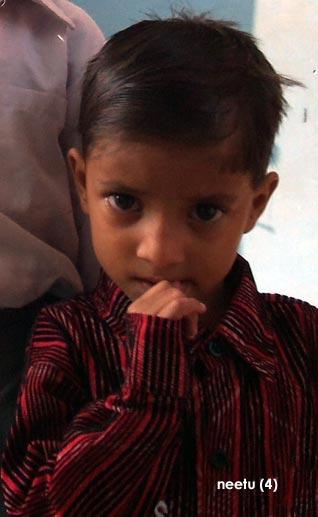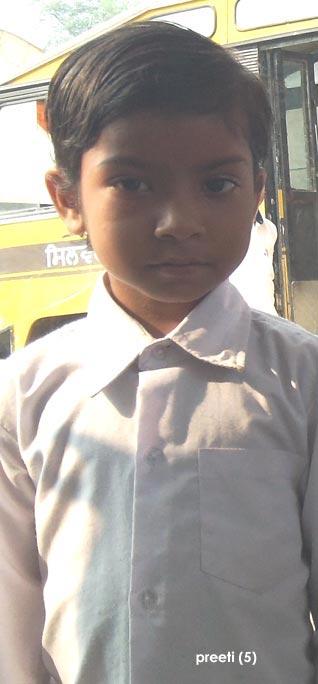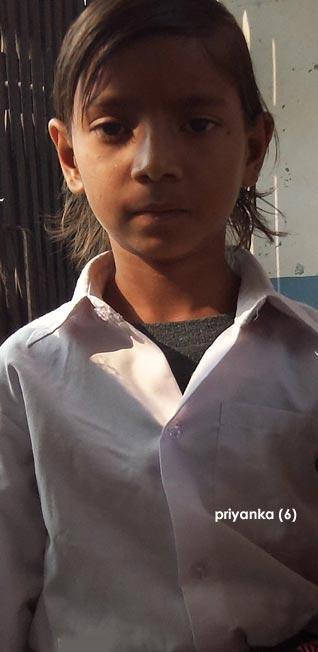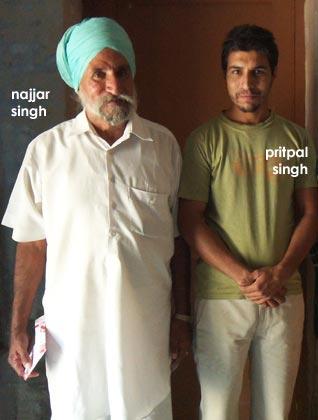Our Heroes
Rescue Me: From “Save the Girl Child†Sloganeering to Reality
by MALLIKA KAUR
Ramphal parked his motorcycle outside Silver Vatika Public School in village Dharampura, District Sangrur.
As usual, he was there to pick up his daughters, Priyanka, Preeti and Neetu. But today, he was not there to take the girls home.
"Let's go get you some new clothes in Bareta," he was heard telling his daughters as he beckoned them to hurry away from Saturday school. The three scampered joyfully from their nursery, lower kindergarten, and upper kindergarten rooms. The three skinny girls clung together on the motorcycle, leaving ample room to spare. Ramphal roared out of the village, careened through some fields, and stopped only when he was at the canal.
Then, one by one, he tossed his daughters into the water. And then, he jumped.
With Punjab's sex ratio being what it is and the prejudices against girls being what they are, this story might have ended right here.
Daughters continue to be viewed - by Hindus and, sadly, many Sikh peasants as well - as a financial burden, given their anticipated dowry, and a social burden, given their perceived ability to hurt family ‘honor' by compromising their chastity. As per the last census, the sex ratio in Punjab has now fallen below 880 girls to 1000 boys and in some areas even as low as 754 girls to 1000 boys (the natural Indian sex ratio is about 950 girls to 1000 boys).
While Ramphal did not have the means to contemplate sex selective abortions, he was dismayed with the birth of each child during the first nine years of his marriage - Priyanka, now age 6; Preeti, age 5; and Neetu, at 4.
And then came Saghal, his only son, now a year and a half. Ramphal left Saghal at home with his wife that Saturday.
"The girls were clinging to him like a baby monkey does to its mother ... Kicking and screaming, he threw each one into the water," recalls Pritpal Singh. The soft-spoken, unassuming farmer is not only an eyewitness, but a true hero.
Pritpal Singh and his field helper, Vicky, heard the loud khat khat of a motorcycle cut through the afternoon quiet as they were walking home from the fields. As their eyes caught up with the noise, they saw a motorcycle take an unusual route, through the farmland. It was all the more unusual that the driver should make this uncomfortable detour with children on the bike. Soon, small screams added to the mystery. The two men ran toward the canal. Ramphal had just thrown the three girls in and now he jumped as well.
Pritpal began undressing for a second, but the realized that the girls would quickly be swept away. He knew the canal was deceptively dangerous - the V-shape meant that the water below moved quickly even though the surface appeared friendlier. So he jumped. Priyanka was trying to hold on to one side wall, while the younger sisters were holding on to each other on the other side. Pritpal struggled to get a hold of all three shivering bodies, while himself being swept downstream.
"He thought he might have to give up, but then he thought of our daughter," offers Pritpal's wife, Harpreet Kaur, proudly.
Pritpal finally made it to the side with all three girls, and Vicky threw in his parna, small turban, and lassoed all of them out to safety.
In a time when courage, selflessness and social responsibility are more often than not reminisced as attributes of "Punjab in the good old days," perhaps Pritpal and Vicky's heroism is all the more commendable. But Pritpal Singh did not make headlines, even though he gave literal meaning to "Save the Girl Child."
Moreover, Pritpal's contribution to gender justice is not limited to this one Saturday.
Pritpal and his wife have adopted a daughter from relatives "who already had two daughters." Just about two-years-old, the chubby, smiling Jasnoor Kaur has "completed the family" and is a sister to their seven-year-old son Harmandeep Singh.
And heroism runs in the family.
Pritpal's father, Najjar Singh, had himself once jumped into a village well to save a young woman who was attempting to kill herself and her infant after feuding with her in-laws. "She lives right here still, and is now a grandmother," gushes Harpreet Kaur about her father-in-law's accomplishment.
"The Guru ordains, we mortals just follow the hukam," smiled Najjar Singh.
But unlike the full life of the woman rescued by Najjar Singh, the family has no delusions that the ordeal for Priyanka, Preeti and Neetu is yet over. "You know the situation of rural debt, people killing themselves and their families in desperation."
Rising rural suicides and deaths have been reported by various groups in recent years. A State Government-commissioned report by Punjab Agriculture University itself reports 2,890 suicides in Districts Bathinda and Sangrur between 2000 and 2008. And the Punjab Farmer's Commission, created by the Punjab State Government in 2005, estimates about 2000 farmer suicides each year. Baba Nanak Education Society, an NGO that adopts families of those who have committed suicide, has documented 1842 suicides in 91 Punjabi villages between 1988 and 2010. These 91 villages are from two sub-subdivisions of District Sangrur, just one of Punjab's 20 Districts.
Such documentation leads to estimates ranging from 50,000 to 90,000 rural suicides in the past two decades. Post-Green Revolution attempts to continue pursuing environmentally and economically unsustainable agrarian practices have led the small and marginal farmers of Punjab to reaping high agrarian debt because of high input costs and low grain prices, and lack of alternate sources of income.
In Ramphal's case, just as there were no completed murders, there was also no suicide. It turned out that Ramphal was unable to avoid the natural human instinct of self-preservation and swam to safety as he saw his girls being saved by the farmers.
Nevertheless, Ramphal's impetus for these desperate actions is similar to the economic hardships faced by many others comprising the above-stated statistics: mounting debt, unregulated high rates of interest, harassment from lenders. Yet Ramphal also represents a new trend. Rural suicides are now no longer limited to the Punjabi farmer, but rather have become the desperate choices of others allied to farming and farming families.
Ramphal owns a small parchoon (petty grocer's) shop in the village. His debt ranges from Rs. 50,000 to 500,000. His wife does not know the amount. But she does know that Ramphal had put their house on sale to repay the creditors who came to his shop regularly. Both she and the neighbors agree that the shop had very little traffic and Ramphal was very worried about making ends meet.
Now that Ramphal is in police custody, charged under Section 307 (attempt to murder), his wife alters her description of their family life, attempting to avoid further adversely affecting his case. From recounting him as "always fighting" for bearing him girls, she now insisted "he distributed laddoos after each birth."
But is locking Ramphal away the solution?
There are a few complicating questions around Ramphal's actions that Saturday. Pritpal Singh remembers another motorcycle, driven by Ramphal's friend, following Ramphal and the girls. Further, another villager, Jaspal, also jumped into the water as Pritpal Singh was bringing the girls to safety. Jaspal reportedly in fact lost his nerve and hung on to Pritpal Singh's foot, almost pulling him down as well.
However, Jaspal was also the only one to receive a monetary award from the District Commissioner's office. Further, Ramphal allegedly sought shelter in this man's home on Saturday night, before the police eventually learnt of the incident and took Ramphal away. So rumors of a larger conspiracy to kill the girls are also making the rounds of the village. But it may also be possible that Ramphal turned up drunk to the school (as the aayaah - maid - remembers), having bolstered his resolve to kill himself and his three financial burdens, and acted out, less from planning and more from depression.
Regardless, Ramphal's wife states the obvious truth: "But he is our only source of support."
While campaigns to increase respect for the girl child are laudable, they must not place girls and women in a ‘special category'; women's empowerment cannot take place in isolation from the surrounding environment. For Ramphal's girls, and any other girls, empowerment depends on an environment with enough employment, food and shelter.
While ‘social change' is put forth as a first priority by government officials and even privileged sections of our society, changing social mores is a long-term effort. Not only will it not take place overnight, it can also not take place in isolation-dowry and wedding spending cannot be eradicated from the villages when it is taking place unabated in cities and promoted in mainstream media, including the giant industry of Bollywood.
When there is the option to raise a daughter without worrying about dowry; to have a daughter provide support in old age without worrying about ridicule; to have a daughter carry forth the family name without shame; to raise a daughter without worrying that violence will be inflicted against her - then Ramphal's attempted murder can be viewed and punished in isolation.
But so long as the choice is between abuse and honor; ridicule and prestige; vulnerability and security; people will choose honor, prestige, and security - Punjabis will chose sons over daughters through one form of violence or another.
Women and men must fight against deeply engrained prejudices. But this fight is not possible on empty stomachs or under the threat of usury practices that threaten to take away land and livelihood.
To aid this fight for gender justice, the government must introduce policy changes. Providing compensation to affected families is indeed a band-aid solution, but band-aids can save lives. Crop insurance and loan forgiveness are initiatives that must last beyond the election seasons. And longer-term solutions require clean industrialization and re-making agriculture profitable not through corporatization but by increasing returns for investment.
To think that saving the Punjabi girl child requires anything less than holistic policy overhauls is to underestimate the gendered nature of economic changes - any relative alterations have disproportionate effects on women, be it in the form of jobs, status, independence, or their lives.
Governmental policy changes will not provide the silver bullet. Nor is waiting for the changes an option, given the urgency for change. One way for the public, civil society, to involve itself is to support NGOs already working on the ground - Rs. 1200 (less than 1 USD a day) provide monthly education and subsistence to a rural family in Sangrur - http://www.bnespunjab.org/rescue-and-revival.htm.
But more immediately, Pritpal Singh and his family, who have fought for gender justice while living on very modest means, can inspire us to challenge our own personal gender biases, whether in matters of pregnancy, childrearing, education, marriages, or beyond.
Mallika Kaur, holds a Master's in Public Policy from the John F. Kennedy School of Government, Harvard University; a J.D. from the University of California, Berkeley School of Law. Her perspectives have been informed by growing up in Punjab and having worked on gender and minority rights issues in South Asia as well as the U.S. since 2001.
February 14, 2011
Conversation about this article
1: I.J. Singh (New York, U.S.A.), February 14, 2011, 4:46 PM.
Truly a depressing reality but a positive, much-needed initiative. Thank you for drawing our attention in a manner that cannot be easily brushed aside.
2: Sangat Singh (Kuala Lumpur, Malaysia), February 14, 2011, 8:13 PM.
Mallika Kaur's compelling piece was the most depressing account, yet redeemed by a streak of hope that could gather strength and turn into a clarion call to wake us up from the deep slumber. "Jis raakhai tis ko-ay na maarai" [GGS:292.11] - 'No one can kill those who are protected by Him.' But, caught in the vicious circle of garisat (family entanlements) without any visible solution, led him into a deep suicidal depression. "Garisat kutamb palaytia-aa kaday harakh kaday sog ..." - 'When you are wrapped up in the attachment of the household and family, sometimes feeling joy and other times sorrow; when you are wandering around in all the four directions, and you cannot sit or sleep for a moment, If you come to remember the supreme Waheguru, then your body and mind shall be cooled and soothed.' In this case, since it was a dire emergency, He dispatched immediately His emissaries in the 'Guru's Service' in the persons of Pritpal Singh and Vicky to rescue the drowning children and the errant father. Here is the appropriate quote. "When everything starts crashing down/ When all I know falls to the ground/ When darkness comes and I can't see/ You're always there to rescue me."
3: Harpreet Singh (Cambridge, MA, U.S.A.), February 15, 2011, 10:28 PM.
Excellent narrative! One interesting point that I would like to add is that, based on a study by National Family Health Survey (2006), surprisingly, educated mothers in the Punjab have a significantly lower sex ratio at 683:1000 than illiterate mothers at 869:1000. I suppose education enables them to engage in sex determination and circumvent laws, unless there's something unusual about the influence of literary discourse in the Punjab to which education gives them access. It's probably a combination of the two. It would be helpful to understand these statistics better and to come up with an alternate discourse that appeals to their religious sensibility. Laws and regulations have failed and other measures - a combination of religious, social and economic - are necessary to bring about a significant change in the thinking of people.
4: Gurpreet Singh (Brampton, Ontario, Canada), February 17, 2011, 12:11 PM.
Can anyone confirm the genuine work done by the NGO listed above. If they are truly working for this good cause, we should come out and help and that's the only way this article would make real sense then. Please, someone confirm their work, so I can proceed with donations.
5: N. Singh (Canada), February 23, 2011, 2:29 AM.
Gurpreet Singh ji: The Baba Nanak Educational Society listed above is headed by Sardar Inderjit Singh Jaijee, Human Rights Activist. He is the author of the book, "The Politics of Genocide". His organization is also working with United Sikhs on the 'Rescue a Family' program whereby people can sponsor a child from a farmer-suicide family to stay in school and complete their education so that the children of suicide-farmers are not forced to abandon their education. It is a worthy cause and organization to contribute to.
6: Ruby Gill (Roselle, U.S.A.), March 30, 2011, 10:39 AM.
I want to help in some way. Please tell me how. Thank you.






